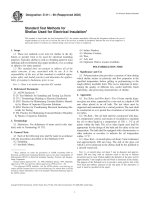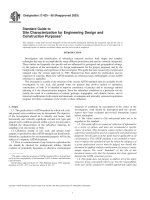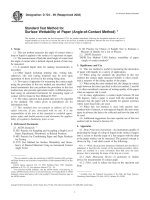Astm d 1459 93 (2003)
Bạn đang xem bản rút gọn của tài liệu. Xem và tải ngay bản đầy đủ của tài liệu tại đây (29.89 KB, 3 trang )
Designation: D 1459 – 93 (Reapproved 2003)
An American National Standard
Standard Specification for
Silicone Varnished Glass Cloth and Tape for Electrical
Insulation1
This standard is issued under the fixed designation D 1459; the number immediately following the designation indicates the year of
original adoption or, in the case of revision, the year of last revision. A number in parentheses indicates the year of last reapproval. A
superscript epsilon (e) indicates an editorial change since the last revision or reapproval.
4.1.1 Type A—For use where primarily electrical properties
are required, and
4.1.2 Type B—For use where primarily physical properties
are required.
1. Scope
1.1 This specification covers clear silicone varnished glass
fabrics in the form of sheets, rolls, and tapes for use as
electrical insulation.
1.2 The product covered by this specification shall be
designed to conform to Class 180 electrical insulating materials
as classified by IEEE Standard No. 1.
1.3 The values stated in inch-pound units are to be regarded
as the standard except temperature which is stated in degrees
celsius.
5. Ordering Information
5.1 Orders for material covered by this specification shall
include the following information:
5.1.1 The form and type (Sections 1 and 4),
5.1.2 The desired nominal thickness, width, and length
(Section 8),
5.1.3 The number of rolls in a package (Section 15), and
5.1.4 The marking on a package (Section 15).
2. Referenced Documents
2.1 ASTM Standards:
D 902 Test Methods for Flexible Resin-Coated Glass Fabrics and Glass Fabric Tapes Used for Electrical Insulation2
D 1711 Terminology Relating to Electrical Insulation2
D 1830 Test Method for Thermal Endurance of Flexible
Sheet Materials Used for Electrical Insulation by the
Curved Electrode Method2
D 3636 Practice for Sampling and Judging Quality of Solid
Electrical Insulating Materials3
2.2 IEEE Standard:4
No. 1 General Principles Upon Which Temperature Limits
are Based in the Rating of Electric Machines and Other
Equipment
6. Materials and Manufacture
6.1 The glass fabric shall be treated with a baking type of
silicone varnish so as to penetrate the fabric and produce a
smooth, non-tacky surface, substantially free of wrinkles,
creases, blisters, and other imperfections.
6.2 The material shall not be spliced. No more than two
pieces shall be used in each multiple of 25 yd (23 m) of linear
length in any one roll of full-width cloth, and no more than two
pieces shall be used in each multiple of 36 yd (33 m) of linear
length in any one roll of tape.
7. Physical Properties
7.1 Breaking Strength—The warp average breaking strength
of the material in the warp thread direction shall be not less
than that prescribed for the corresponding types and nominal
thicknesses designated in Table 1.
3. Terminology
3.1 Definitions: For definitions of terms used in this standard, refer to Terminology D 1711.
4. Types
4.1 This specification covers two types of silicone varnished
glass fabrics as follows:
8. Dimensional Requirements
8.1 Thickness—The average thickness shall not vary more
than 60.5 mil (0.013 mm) from the nominal thicknesses for
specified thicknesses up to and including 5 mils (0.13 mm), and
610 % from the nominal thickness for specified thicknesses
above 5 mils.
8.2 Width—Full-width rolls and sheets shall be 36 61 in.
(900 625 mm) in width, and shall be supplied trimmed unless
otherwise specified. The width of individual tapes shall not
vary more than 61⁄32 in. (0.8 mm) from the specified width for
1
This specification is under the jurisdiction of ASTM Committee D09 on
Electrical and Electronic Insulating Materials and is the direct responsibility of
Subcommittee D09.07 on Flexible and Rigid Insulating Materials.
Current edition approved March 10, 2003. Published April 2003. Originally
approved in 1957. Last previous edition approved in 1998 as D 1459 – 93 (1998).
2
Annual Book of ASTM Standards, Vol 10.01.
3
Annual Book of ASTM Standards, Vol 10.02.
4
Available from The Institute of Electrical and Electronics Engineers, Inc., 445
Hoes Lane, Piscataway, NJ 08854–1331.
Copyright © ASTM International, 100 Barr Harbor Drive, PO Box C700, West Conshohocken, PA 19428-2959, United States.
1
D 1459 – 93 (2003)
TABLE 1 Dielectric and Breaking Strength Requirements
Nominal
Thickness, mils
(mm)
3
4
5
7
10
12
15
20
25
(0.076)
(0.102)
(0.127)
(0.178)
(0.254)
(0.305)
(0.381)
(0.508)
(0.635)
Breaking Strength, lbf/in.
(N/mm) of width
Dielectric Strength, as Received V/mil
(kV/mm)
Type
A
Type
B
Type
A
Type
B
Type
A
70 (12.25)
70 (12.25)
70 (12.25)
100 (17.51)
150 (26.27)
150 (26.27)
250 (43.79)
300 (52.54)
... ...
... ...
... ...
100 (17.51)
150 (26.27)
250 (43.79)
250 (43.79)
300 (52.54)
350 (61.29)
350 (61.29)
1300 (51.2)
1300 (51.2)
1300 (51.2)
1200 (47.3)
1100 (43.3)
1100 (43.3)
650 (25.6)
400 (15.8)
...
...
...
...
...
...
1000 (39.4)
1000 (39.4)
450 (17.7)
600 (23.6)
400 (15.8)
300 (11.8)
300 (11.8)
3 700
5 000
6 200
8 000
10 500
12 500
9 000
7 200
...
tapes 11⁄2 in. (38 mm) or less in width, nor more than 61⁄16 in.
(1.6 mm) for tapes over 11⁄2 in. in width.
8.3 Length—The nominal length per roll shall be as specified in the purchase order. The measured lengths of individual
rolls or sheets shall be not less than that specified.
8.4 Core—Material in roll or tape form shall be supplied on
cardboard cores the inside diameter of which shall be 11⁄2 in.
(38 mm), unless otherwise specified.
50
96
Permittivity, max
0.020
0.20
4.5
7.0
4
6
4
6
5
5
6
...
...
500
000
000
000
000
000
000
13. Inspection
13.1 Unless otherwise agreed upon between the purchaser
and seller, the material shall be inspected and tested within 3
weeks of receipt by the purchaser.
13.2 Inspection of the material shall be agreed upon between the purchaser and the supplier as part of the purchase
contract.
10. Electrical Requirements
10.1 Dielectric Strength (As Received)— Minimum acceptable average values of dielectric strength, as received, are
given in Table 1.
10.2 Dielectric Breakdown (Before and After Baking)—Use
the procedure for Effect of Elevated Temperature of Test
Methods D 902.
10.2.1 Minimum acceptable average dielectric breakdown
voltages after bending with no baking are given in Table 1.
10.2.2 Minimum acceptable average dielectric breakdown
voltages after baking and then bending are as follows:
10.2.2.1 Type A—85 % of the values obtained in 10.2.1,
10.2.2.2 Type B—25 % of the values obtained in 10.2.1 but
not less than 150 V/mil (5.9 kV/mm) when the breakdown
voltage obtained is converted into a dielectric strength value.
10.3 Dissipation Factor and Permittivity (Type A only)—
Type A material shall conform to the following requirements
for dissipation factor and permittivity, after conditioning for 96
h at 23°C at both 50 % and 96 % relative humidity and when
tested at 23°C and at 60 Hz.
Dissipation Factor,
max
Type
B
12. Test Methods
12.1 Condition and test silicone varnished glass fabric in
accordance with Test Methods D 902.
12.2 Number or mark all specimens taken from a single roll
so that any failures can be identified with the roll.
9. Thermal Requirements
9.1 Silicone varnished glass fabric shall have a temperature
index at 20 000 h of 180 minimum when tested in accordance
with Test Method D 1830.
Relative
Humidity %
Breakdown Voltage,
after Bending, total, V
14. Rejection and Rehearing
14.1 Material that fails to conform to the requirements of
this specification may be rejected. For purposes of this specification, the failure of any roll or sheet to meet one or more of
the requirements of Sections 6 through 8 shall constitute one
roll or sheet failure. Failure of 20 % or more of the rolls or
sheets sampled shall constitute cause for rejection of the entire
lot.
14.2 Rejection shall be reported to the producer or supplier
promptly and in writing within 4 weeks after the receipt of the
material, unless otherwise agreed upon.
14.3 In the case of a dispute concerning the results of the
tests, the producer or supplier shall be permitted to make a
claim for a rehearing.
15. Packaging and Package Marking
15.1 The purchaser shall specify the number of rolls or
sheets in each package and whether the rolls or packages or
both shall be sealed with a moisture-resistant wrap or coating.
The wrapping shall be secure and shall protect the contents.
15.2 The purchaser shall specify the marking to be applied
to each package. In the absence of specific instructions, the
packages shall be marked in accordance with acceptable
industry practice.
11. Sampling
11.1 Select samples in accordance with Method D 3636,
using the Inspection Levels and Acceptable Quality Levels
(AQL) as agreed upon between the purchaser and the supplier.
16. Keywords
16.1 electrical insulation; glass cloth tape; silicone varnished glass fabric
2
D 1459 – 93 (2003)
ASTM International takes no position respecting the validity of any patent rights asserted in connection with any item mentioned
in this standard. Users of this standard are expressly advised that determination of the validity of any such patent rights, and the risk
of infringement of such rights, are entirely their own responsibility.
This standard is subject to revision at any time by the responsible technical committee and must be reviewed every five years and
if not revised, either reapproved or withdrawn. Your comments are invited either for revision of this standard or for additional standards
and should be addressed to ASTM International Headquarters. Your comments will receive careful consideration at a meeting of the
responsible technical committee, which you may attend. If you feel that your comments have not received a fair hearing you should
make your views known to the ASTM Committee on Standards, at the address shown below.
This standard is copyrighted by ASTM International, 100 Barr Harbor Drive, PO Box C700, West Conshohocken, PA 19428-2959,
United States. Individual reprints (single or multiple copies) of this standard may be obtained by contacting ASTM at the above
address or at 610-832-9585 (phone), 610-832-9555 (fax), or (e-mail); or through the ASTM website
(www.astm.org).
3









